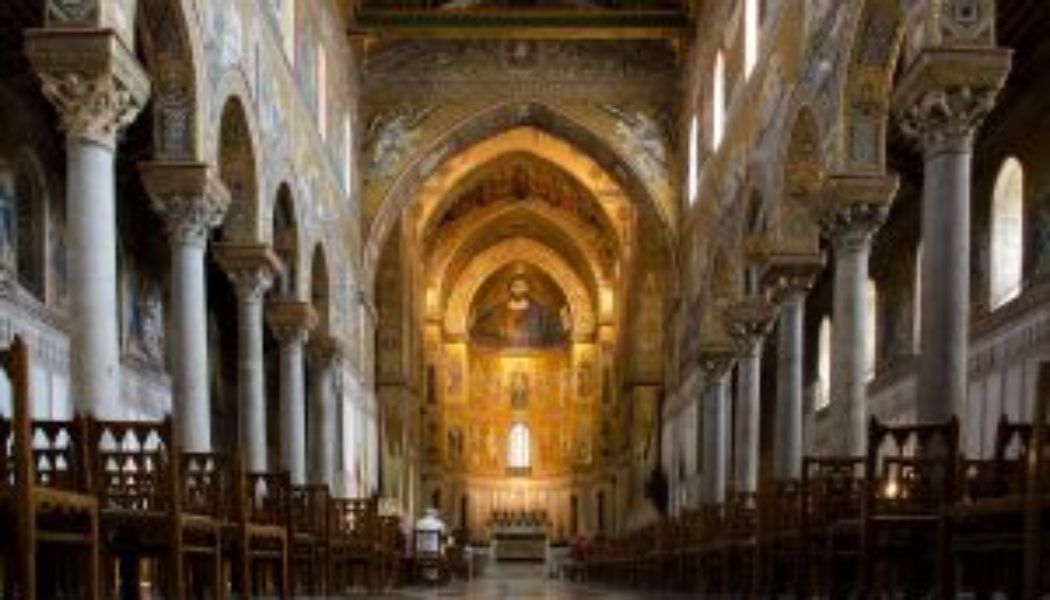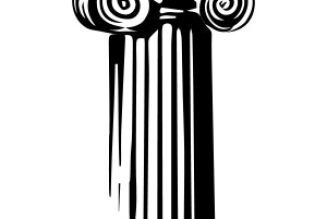The fine arts are rightly classed among the noblest activities of man’s genius; this is especially true of religious art and of its highest manifestation, sacred art. Of their nature the arts are directed toward expressing in some way the infinite beauty of God in works made by human hands. Their dedication to the increase of God’s praise and of his glory is more complete, the more exclusively they are devoted to turning men’s minds devoutly toward God. —Sacrosanctum Concilium No. 122
 How can we recover the sense of the sacred in our temples and shrines? We seem to have lost the ability to make new buildings which exude that ineffable sense of the “sacred” which can be rightly called the presence of the Almighty. Why is it that few of our churches built in recent decades intimate that the church building itself and the celebrations taking place within it are sacred?
How can we recover the sense of the sacred in our temples and shrines? We seem to have lost the ability to make new buildings which exude that ineffable sense of the “sacred” which can be rightly called the presence of the Almighty. Why is it that few of our churches built in recent decades intimate that the church building itself and the celebrations taking place within it are sacred?
Recent church structures often seem “of this world” rather than “otherworldly,” “down to earth” rather than “heavenly,” more secular than sacred. In this increasingly secular age our houses of worship, by blending in with contemporary architecture, are in danger of becoming mere theaters and assembly halls rather than sacred and prophetic places.
Yet why should we seek to promote and restore sacred architecture if it has been lost? We seek to restore the practice of a sacred architecture because it is part of our Catholic patrimony, in the same way that images of the Annunciation, Last Supper, and Crucifixion are. They are a catechism in paint, mosaic, and stone. Yet, to compare even the most critically-acclaimed modern churches with typical early Christian or Renaissance examples is to call into question any notion of progress in the arts. How will our ecclesiastical works be judged in relation to our forefathers, who were able to create great works of art in spite of their limited resources and rudimentary technology?
The great appreciation shown for classical and medieval churches by pilgrim and art historian alike strongly indicates that these buildings continue to be relevant to contemporary culture, and that modern man still has a sense of the sacred. As long as Medieval churches and ancient basilicas continue to be places for the liturgy and devotion, sacred architecture cannot be lost. In fact, today we are witnessing a growing number of enlightened patrons and talented architects who are bringing about a new renaissance in sacred architecture, promoting the sense of the holy in our houses of God.
A Place Set Apart
To create three-dimensional places of worship is fundamental to human nature. Sacred architecture is a means for us to articulate the meaning of life for ourselves, our communities, future generations . . . and to honor God, because, though He does not need our worship nor our temples of stone, He deserves them greatly. Our response to the cross is to return His love in our thoughts and deeds, by feeding the hungry and also by building churches. When we come in contact with the Almighty we stand on holy ground. Thanksgiving and worship cause us to set aside those places where God has made his presence known to his people: the holy mountain, the upper room, the tent in the wilderness, and the temple in the Holy City. While none of these places can contain the Deity, they offer witness to His benevolence and to His presence with us.
From the earliest days of Christianity, believers set aside places for corporate worship and private prayer. We see poignant examples of this at Dura-Europos and in the decoration of the catacombs. With the edict of Milan, Constantine’s architects were faced with the challenge of creating large sacred buildings in Rome, the Holy Land, and Byzantium. Their solution was to create holy places through a processional architecture of colonnaded naves and apsed sanctuaries, with rood screens and baldacchinos. All later innovations (up until the mid-20th century) can be seen as in continuity with these archetypal embodiments of the sacred.
But is not a church building by definition “sacred,” in spite of its architecture and iconography? Is it not the dedication of the church, the altar stone, the places for the sacraments, the holy icons, and the faithful who worship there that make a building sacred? Without these aspects, Chartres cathedral and St. Peter’s basilica are merely genius works of architecture and not sacred places. So, at one level, the meanest shelter can be a sacred building by virtue of the sacred liturgy and the holy Eucharist held within. But on another level, the architecture of beautiful churches, whether Sainte-Chapelle in Paris or St. Vincent Ferrer in New York, embodies the sense of the sacred so completely that it is possible to speak of it as a “sacred architecture.” And so we witness the great effect of Chartres and St. Peter’s on believers and unbelievers alike, due in part to their soaring spaces, durable construction, exquisite iconography, and representation as the house of God within the landscape.
The Church As a Sacramental Building
How can the architecture of a church reinforce or express the sacredness brought to it by the dedication, the liturgies, the sacraments, and the people of God who worship there? Through the architectural composition and individual motifs, a church building should highlight the place of the liturgical elements and the sacraments. By placing icons within aedicules, testers over the Blessed Sacrament, and baldacchinos over the altar, the architecture focuses our attention on the sacred elements. Employing fine materials, increased ornamentation, and archetypal forms at liturgical and sacramental places invites the visitor to draw near and receive God’s grace offered in the sacraments. Giving honor to the sacraments through the placement and design of the baptistry, confessional, ambry, tabernacle, altar, and altar rail further articulates the nature of the church as a sacramental house.
Though not a sacrament itself, the architecture of the temple refers to the sacraments, most especially to the Blessed Sacrament, and for this reason it can be considered a “sacramental architecture.” Just as a sacrament is a visible expression of an invisible reality, so a sacramental architecture portrays through bricks and mortar the mystery of salvation. Thus the architecture of the exterior of the church should remind us of Holy Communion, or baptism, or of marriage. But how?
One way is through reference to those architectural elements that articulate the sanctuary, altar, tabernacle, confessional, altar rail and shrines within. At the Gesù in Rome, the façade is made up of paired pilasters which preview the design of the nave and frame the side chapels. A sacramental referencing on the exterior can also be accomplished by employing bas-reliefs of the Eucharist and other sacraments, personifications of the virtues, or a baldacchino or triumphal arch over the portal. In addition, the inclusion of effigies of saints, tombs, and angels on the roof all indicate the sacred reality of the interior.
The architecture of the sacred presents Christianity in a three-dimensional form: visually, tactilely, and sonorously in time. The sacred must come to us through all the senses, to surround us with intimations of what Abraham felt in front of the burning bush, King David in front of the ark, Mary with the angel Gabriel, and the disciples at the feet of Jesus and at the foot of his cross. The stone under foot, the wood of our seats, the smells of incense and of beeswax, the smoothness of the marble, the strength of the cast iron grillwork and rails, and the paint on the canvas all help to create a sense of the sacred and prepare us for the taste of sacred bread and wine.
To Design Sacred Buildings
Even though as a medium it is abstract, architecture can articulate the truths of faith like its sister arts of music, painting and sculpture. To accomplish this architects use archetypal forms such as porticos, belltowers, colonnades, and vaulting, all of which have developed layers of meaning over the millenia. These forms envelop the pilgrim and, when done beautifully, create an unconscious effect upon his soul. These forms are composed of elements—such as Corinthian columns, vertical proportions and Christian symbols—that have been universally employed over two millennia to define the sacred. Coherence and unity are ensured when the building is designed using the rich patrimony of Classical or Medieval architectural languages.
To design sacred buildings is to help dispose visitors to contemplating the things above, to be aware of the holy, and to embrace the eternal within the ephemeral. People should see and feel that they are entering a place out of the ordinary, a place in which the concerns of life can be seen in relation to eternity. There should be a certain mystery, or even a strangeness, expressed by the architecture. A sacred place should not be convenient to enter like a department store, comfortable like a café, or predictable like a lecture hall. Rather, as a place whose reason for existence is to foster the encounter with the divine, it must be designed in a way that helps us to focus on the Divinity.
A Sacred Building For Today
If we are open to the Sacred, it will grip us as we approach the church, or even when we see its dome or spires from afar. Upon entering, the architecture will carry our eyes and then our hearts toward God, toward heaven. The material embodiment of the sacred will draw us out of ourselves by being beautiful, harmonious, and transcendent. Within the nave there will be spacious and uplifting areas, such as at the crossing or above the altar. The infinite will be articulated by distant spaces such as the choir, the triforium, or a Lady Chapel beyond the sanctuary.
There will also be more intimate areas of mysterium tremendum: side chapels for prayer and daily liturgy, elaborately carved confessionals, sumptuous and colorful materials, and corner shrines with candles flickering before gold-covered icons. There will be many levels of iconography and meaning, many stops along the way, and many places for our eyes to rest. And it will be done with good order and clear hierarchy of all the parts. Most important of these parts is the sanctuary, the place of the Sanctus, where the angels sing, “Holy, holy, holy is the Lord God of Hosts!”
This representation of the heavenly liturgy within the sanctuary is consonant with its role as the focus of the church building. The sanctuary is filled with a celestial light, different in quality from the nave (whether it is mysterious and quiet, or golden and bright). The marble steps, triumphal arch sitting on columns, and altar rail heighten our awareness of the sacred mysteries. They also help set apart this Holy of Holies, the place of the ordained priesthood and the sacrificial altar. With a greater sense of detail, materials, and iconography, the architecture of the sanctuary will be the culmination of the church. A marble altar and bronze tabernacle are the ultimate embodiment of the sacred, the presence of Christ dwelling with man, and are highlighted by columns, sculpture, bronze torcheres, and sacred altarpieces.
In his Letter to Artists, Pope John Paul II wrote, “In order to communicate the message entrusted to her by Christ, the Church needs art. Art must make perceptible, and as far as possible attractive, the world of the spirit, of the invisible, of God. It must therefore translate into meaningful terms that which is in itself ineffable.”[1] Today, we see numerous architects and patrons who are answering the Holy Father’s call. In this way the architecture of the sacred shall be restored to its place of prominence in the Third Millennium, and offer once again houses of prayer for mankind and temples worthy of God and His sacred liturgy.
*This essay is adapted from the introduction to The Church Building as a Sacred Place: Beauty, Transcendence, and the Eternal by permission of the author. It first appeared here February, 2013. Readers of this essay may also enjoy Depicting the Whole Christ: Hans Urs von Balthasar & Sacred Architecture.
The Imaginative Conservative applies the principle of appreciation to the discussion of culture and politics—we approach dialogue with magnanimity rather than with mere civility. Will you help us remain a refreshing oasis in the increasingly contentious arena of modern discourse? Please consider donating now.
*Pope John Paul II, Letter to Artists (April 4, 1999), 12:1-3.
Join Our Telegram Group : Salvation & Prosperity









